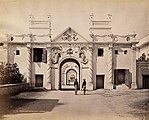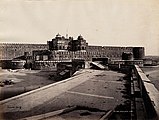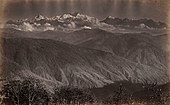Samuel Bourne
This article includes a list of general references, but it lacks sufficient corresponding inline citations. (March 2009) |
Samuel Bourne | |
|---|---|
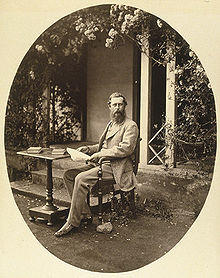 | |
| Born | 30 October 1834 Staffordshire, England |
| Died | 24 April 1912 |
| Occupation | Photographer |
| Style | Landscapes, Ethnographic Portraits |
Samuel Bourne (30 October 1834 – 24 April 1912)[1] was a British photographer known for his prolific seven years' work in India, from 1863 to 1870.[2] Together with Charles Shepherd, he set up Bourne & Shepherd first in Shimla in 1863 and later in Kolkata (Calcutta); the company closed in June 2016.[3][4][5]
Early life and education
Samuel Bourne was born on 30 October 1834, at Napley Heath, near Mucklestone, on the Staffordshire and Shropshire border to Thomas Bourne (b. 1804) and his wife Harriet née Dobson (b. 1802).[6][7] After being educated by a clergyman near Fairburn, he secured a job with Moore and Robinson's Bank, Nottingham in 1855. His amateur photographic activities started at about this time and he quickly became an accomplished landscape photographer, soon lecturing on photography and contributing technical articles to several photographic journals.
In 1858, Bourne made a photographic tour of the
Work in India
He initially set up in partnership with an already established Calcutta photographer, William Howard. They moved up to Simla, where they established a new studio 'Howard & Bourne', to be joined in 1864 by Charles Shepherd, to form 'Howard, Bourne & Shepherd'. By 1866, after the departure of Howard, it became 'Bourne & Shepherd', which became the premier photographic studio in India, and until it closed in June 2016[8] was perhaps the world's oldest photographic business.[citation needed] Charles Shepherd evidently remained in Simla, to carry out the commercial and portrait studio work, and to supervise the printing and marketing of Bourne's landscape and architectural studies, whilst Bourne was away travelling around the sub-continent.
Bourne spent six extremely productive years in India, and by the time he returned to England in January 1871, he had made approximately 2,200 fine images of the landscape and architecture of India and the Himalayas. Working primarily with a 10x12 inch plate camera, and using the complicated and laborious Wet Plate Collodion process, the impressive body of work he produced was always of superb technical quality and often of artistic brilliance.[citation needed] His ability to create superb photographs whilst travelling in the remotest areas of the Himalayas and working under the most exacting physical conditions, places him firmly amongst the very finest of nineteenth century travel photographers.[citation needed]
On 29 July 1863, he left Simla on the first of his three major Himalayan photographic expeditions. With a retinue of some 30 porters to carry his equipment, he travelled across the Simla Hills to Chini, in the Valley of the
In the following year, Bourne set out on another major trip, this time a nine-month trip to
) before arriving in Lucknow on Christmas Eve 1864.The studio business prospered, and in 1866, they opened a second branch in
Some time shortly after his return to England, he sold off his interests in Bourne and Shepherd studios, and from then on, had nothing more to do with commercial photography; however his archive of some 2,200 glass plate negatives remained with the studio, and were constantly re-printed and sold over the following 140 years, until their eventual destruction in a Calcutta fire on 6 February 1991.
Return to England
Bourne settled back in Nottingham, where he founded a cotton-doubling business, in partnership with his brother-in-law J.B. Tolley. The business prospered, and Bourne become a local magistrate. Although continuing to photograph as a relaxation, and belonging to the local Photographic Society, much of his creative energy from this time onwards was devoted to watercolour. He died in Nottingham on 24 April 1912.
Bourne is justly regarded as one of the finest landscape and travel photographers of 19th-century India; combining a fine eye for composition with high technical expertise.[citation needed]
Collections
Bourne's work is held in the permanent collections of several museums, including the
Gallery
-
Photograph of the Taj Mahal. Samuel Bourne, 1860s.
-
Photograph of the Taj Mahal from the river. Samuel Bourne, 1860.
-
Gateway to the Hooseinabad Bazaar in Lucknow, 1863–66 V&A Museum no. 7-1972
-
Photograph of Ramnath temple of Newalipore from Views of Calcutta and Barrackpore, taken by Samuel Bourne.
-
Samuel Bourne, "Plate Figures on the Linga Chapel. Elephanta," 1863–1869, photograph mounted on cardboard sheet
-
Samuel Bourne, "Palace & Tank. Built by Rajah Bulman Singh. Goverdhun 1311]," 1863–1869, photograph mounted on cardboard sheet
-
Samuel Bourne, "The Motee Musjid. Delhi. 1351," 1863–1869, photograph mounted on cardboard sheet
-
Samuel Bourne, "The Palace. Delhi. Interior of Dewan-i-Kass. 1350," 1863–1869, photograph mounted on cardboard sheet
-
Samuel Bourne, "Mausoleum of Prince Etmad-Dowlah. Agra. 1232," 1863–1869, photograph mounted on cardboard sheet
-
Samuel Bourne, "The Mermaid Gate, Kaiser Bagh. Lucknow, 1041," 1863–1869, photograph mounted on cardboard sheet
-
Samuel Bourne, "Interior of Zenana in Fort. Agra, 1224," 1863–1869, photograph mounted on cardboard sheet
-
Samuel Bourne, "The Taj from Fountain. Agra," 1863–1869, photograph mounted on cardboard sheet
-
Samuel Bourne, "The Fort. Delhi Gate. Agra," 1863–1869, photograph mounted on cardboard sheet
-
Samuel Bourne, "Memorial Well, Marble Statue by Marochetti. Cawnpore, 1206," 1863–1869, photograph mounted on cardboard sheet
-
Samuel Bourne, "Upper Portion of the Palace, Goverdhun, 1312," 1863–1869, photograph mounted on cardboard sheet
-
Samuel Bourne, "Front of the Motee Musjid, Agra, 1220," 1863–1869, photograph mounted on cardboard sheet
-
Samuel Bourne, "Burning Ghat, Benares, 1169," 1863–1869, photograph mounted on cardboard sheet
-
Samuel Bourne, "Gate of the Taj. Bagh View. Agra. 1014," 1863–1869, photograph mounted on cardboard sheet
-
Samuel Bourne, "Views of India, Plate 22," 1863–1869, photograph mounted on cardboard sheet
-
Samuel Bourne, "Views of India, Plate 21," 1863–1869, photograph mounted on cardboard sheet
-
Samuel Bourne, "Views of India, Plate 18," 1863–1869, photograph mounted on cardboard sheet
-
Samuel Bourne, "Views of India, Plate 17," 1863–1869, photograph mounted on cardboard sheet
-
Samuel Bourne, "Views of India, Plate 15," 1863–1869, photograph mounted on cardboard sheet
-
Samuel Bourne, "Views of India, Plate 14," 1863–1869, photograph mounted on cardboard sheet
-
Samuel Bourne, "Views of India, Plate 12," 1863–1869, photograph mounted on cardboard sheet
-
Samuel Bourne, "Views of India, Plate 11," 1863–1869, photograph mounted on cardboard sheet
-
Samuel Bourne, "Views of India, Plate 9," 1863–1869, photograph mounted on cardboard sheet
-
Samuel Bourne, "Views of India, Plate 8," 1863–1869, photograph mounted on cardboard sheet
-
Samuel Bourne, "Views of India, Plate 5," 1863–1869, photograph mounted on cardboard sheet
-
Samuel Bourne, "Views of India, Plate 3," 1863–1869, photograph mounted on cardboard sheet
See also
Notes
- ^ Photographs of India. circa 1862 – circa 1872 – Samuel Bourne Biography Cambridge University Library.
- ISBN 0-85945-001-5. Page 37.
- ^ http://www.thehindu.com/news/cities/kolkata/Oldest-running-studio-in-the-world-shuts-down/article14433884ece[permanent dead link]
- ^ Bourne & Shepherd, Esplanade , Kolkata, India – Image[permanent dead link] Flickr
- Indian Express, 19 July 2007.
- ^ England, Staffordshire Parish Register, Mucklestone, St Mary (1834), #1048
- doi:10.1093/ref:odnb/38594. Retrieved November 11, 2016. (Subscription or UK public library membershiprequired.)
- ^ "Oldest running photo studio in the world shuts down". The Hindu. June 19, 2016.
- National Portrait Gallery.
- ^ "Charles Shepherd | Princeton University Art Museum". artmuseum.princeton.edu. Retrieved March 15, 2021.
- ^ Harvard. "From the Harvard Art Museums' collections Humayun's tomb, Delhi, Samuel Bourne no. 1362". harvardartmuseums.org. Retrieved March 15, 2021.
- ^ "Samuel Bourne in the permanent collection of the National Gallery of Art, Washington, DC". National Gallery of Art, Washington, DC. Retrieved August 17, 2021.
- ^ "Bridge, India". dia.org. Retrieved March 15, 2021.
- ^ "City with River in Middle Ground". clarkart.edu. Retrieved March 15, 2021.
- ^ "Loading... | Collections Online – Museum of New Zealand Te Papa Tongarewa". collections.tepapa.govt.nz. Retrieved March 15, 2021.
- ^ "Samuel Bourne. Poplar Avenue, from the Middle, Kashmir. 1864 | MoMA". The Museum of Modern Art. Retrieved March 15, 2021.
- ^ "Brooklyn Museum". brooklynmuseum.org. Retrieved March 15, 2021.
- ^ Museum, Victoria and Albert. "Village of Sungnam, Hungrung Pass, India | Bourne, Samuel | V&A Explore The Collections". Victoria and Albert Museum: Explore the Collections. Retrieved March 15, 2021.
- ^ "Samuel Bourne". Metropolitan Museum of Art. Archived from the original on June 9, 2023. Retrieved June 9, 2023.
- ^ "Exchange: The Fort -Agra- Palace of Akhar (marble)/ Taj in distance". exchange.umma.umich.edu. Retrieved March 15, 2021.
- ^ "Samuel Bourne".
- ^ "Samuel Bourne". nationalgalleries.org. Retrieved March 15, 2021.
- ^ "Bourne, Samuel". SFMOMA. Retrieved March 15, 2021.
References
- Arthur Ollman, Samuel Bourne: Images of India, a profound book on Bourne and his photography. ISBN 0-933286-36-8
- Bourne & Shepherd (floruit 1865-) National Portrait Gallery
- Carsten Rasch, The photographic work of Samuel Bourne – Photographs of Indien and Himalayas. ISBN 978-3734761-83-6
- Hugh Rayner, ed., Photographic Journeys in the Himalayas by Samuel Bourne. The complete texts of four series of letters by Samuel Bourne to the British Journal of Photography, originally published between 1 July 1863 and 1 April 1870. A newly revised and enlarged edition, with additional appendices, including a Catalogue of almost the entire body of some 2,200 photographs, taken by Bourne in India, together with the text of two of his lectures: On Some of the Requisites Necessary for the Production of a Good Photograph from 1860, and The Original Fothergill Process, first published in 1862. It includes previously unidentified photographs of him during his travels, an enlarged bibliography and other new material, including fragments of Samuel Bourne's own poetry. 3rd (revised & enlarged) edition 2009. Published by Pagoda Tree Press, Bath, England. ISBN 978-1-904289-64-7
- Lenman, Robin (ed.) 2005 The Oxford Companion to the Photograph (Oxford: Oxford University Press) [Includes a short biography on Bourne & Shepherd.]
- The Imperial Gaze. The Photographs of Samuel Bourne (1863–1870). 28-page catalogue of exhibition, with 17 images essay, notes and bibliography. The Alkazi Collection of Photography and Sepia (2004).

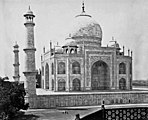



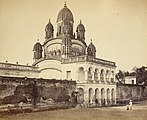

![Samuel Bourne, "Palace & Tank. Built by Rajah Bulman Singh. Goverdhun 1311]," 1863–1869, photograph mounted on cardboard sheet](http://upload.wikimedia.org/wikipedia/commons/thumb/a/a4/Palace_Rajah_Bulman_Singh_dli_A136_cor.jpg/162px-Palace_Rajah_Bulman_Singh_dli_A136_cor.jpg)



